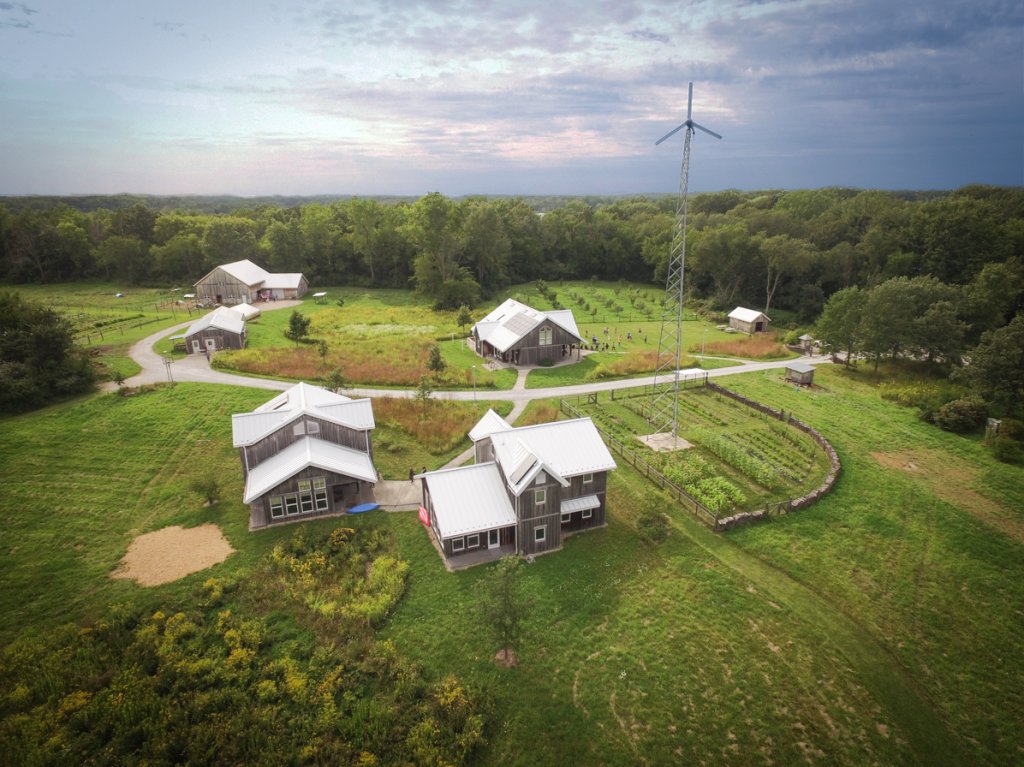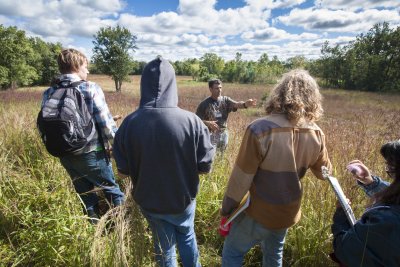Merry Lea’s first half century, part one: Fifty years of land management
When did Merry Lea begin? Was it the moment in 1964 when the founding donor, Lee Rieth, came home and informed his wife, Mary Jane, that he had bought 80 acres of land in Noble County?
“You did what?” Mary Jane gasped. She loved telling this story.
Perhaps an organization committed to environmental education launches when the first researcher composes a species list. Or does it begin when the first child visitor finds a turtle and smiles? We are taking the conventional approach and dating the 50-year mark from 1967 when the articles of Caption incorporation as a nonprofit were signed.
No matter how you count them, Merry Lea has had many beginnings in its 50-year history. This is an innovative organization! The timeline on pages 1, 4, 5 and 6 captures some of these firsts and the ways in which Merry Lea has developed. Main articles sketch a brief history of Merry Lea’s land, its educational endeavors and the ways it has fed body, mind and spirit.
We regret that space constraints have left many important people and events unmentioned.

Fifty years of land management: “providing a sanctuary for Indiana’s plants and animals”
Carol Good-Elliott still remembers the disorientation she felt the winter of 2000 when she returned to Merry Lea to hike shortly before she joined the staff as an environmental educator. Things were not as she remembered them a decade earlier when she’d worked here as a student.
Back in 1989, Good-Elliot had mowed trails through the reed canary grass in a low basin north of the Learning Center. What had become of those trails? Instead there was water lapping at her feet. This was her first encounter with today’s Onion Bottom wetland restoration. Meanwhile, the field where she’d shocked wheat in preparation for the Sunflower Festival had become the Kesling Wetland.
While Merry Lea’s mission to provide sanctuary for Indiana’s plants and animals has remained constant, the land and its management have both evolved over the years.
According to Bill Minter, who has served as Merry Lea’s land manager since 1991, the care that the land received has occurred in three overlapping phases. These emphases parallel the land management practices taught and practiced elsewhere at the time. Many other landowners were doing similar things on a smaller scale.
The Planting Era
The 1960s and 70s can be described as Merry Lea’s planting era. At this time, most of the newly acquired herbaceous areas were either old farm fields or still under cultivation. Records from the 1960s record corn harvests from land leased to local farmers.
The Rieths’ impulse, echoing the spirit of the times, was to plant these areas to improve wildlife habitat. A 1967 letter from Merry Lea’s first director, Doug Waldman, describes the direction as follows:
Mr. Rieth is quite concerned about getting various plantings started next spring and in great numbers….Within this border, Mr. Rieth wants as many different species as possible. He is also quite concerned about food patches or feeding areas.
Waldman acted on these instructions, and a letter from January 23, 1969, indicates that 3,290 trees and shrubs were purchased for $502.
At that time, the conventional wisdom did not distinguish between the use of native species and exotic species in land restoration. Autumn olive shrubs were planted in great numbers as wildlife food and cover, and university extension agents considered crown vetch a wonderful solution to erosion problems. These species were planted at Merry Lea, along with many non-native trees such as Scotch pine, Colorado blue spruce and pinyon pine. No one yet knew that some of these exotics would spread and form monocultures, choking out the Indiana species.
Minter, who now battles aggressive autumn olive and crown vetch, is not judgmental about these decisions. He recalls recommending autumn olive himself in the early 1980s. “The best thing they did was to plant something rather than leave the land barren. The worst thing they did was to plant species like Scotch pine,” he says.
The Cataloging Era

The transfer of Merry Lea to Goshen College in 1980 brought a new level of curiosity about the resident flora and fauna. Dr. Larry Yoder, who became the executive director soon afterwards, was a botanist with the training to recognize the ecological value of sites such as the Bear Lake Prairie. Attention turned to cataloguing what species lived on the land.
Goshen College biology students and volunteers examined ecosystems in depth. In 1983, Steve Yoder (class of ‘85) repeated a study Dr. Alton Lindsey began in 1972 documenting the growth of a tract of oak-hickory forest. In 1988, Volunteer Christine Guth found and preserved many plants for the herbarium. Kevin Bacher (class of ’89), returned in 1990 as a Lindsey Teaching Fellow. During his two years at Merry Lea, he surveyed bird and plant populations and prepared species lists still in use. Tony Swinehart, (class of ’92), studied Merry Lea’s bogs, finding uncommon species such as purple pitcher plant and pink lady’s slipper orchid.
Dave Miller, an entomologist, arrived as the new program director in 1988 and began an insect collection that current entomology students still use. His first “Nature Notes” column appeared in the Merry Leaflet in December of that year. From boxelder bugs to bobwhite quail, each column described a species in detail. In 1989, Dr. Mary Linton arrived at Goshen College bringing expertise in wetland ecology. She studied the salamander populations at Merry Lea.
The Restoration and Management Era
By the time that Bill Minter was hired in 1991, the field of conservation no longer assumed that native ecosystems could remain pristine if simply left alone. Land managers were seeing the need to protect and manage ecosystems.
“I don’t plant any trees. We don’t need more trees and I don’t want to feed deer…I need to spray and burn and contain,” Minter says, referring to the invasive species he keeps in check. One of his goals is to provide as much ecosystem diversity as possible for Merry Lea’s educational functions.

Between 1991 and the present, Minter undertook eight wetland restorations totaling 52 acres. His wetland toolkit includes assessing soils to find sites that were previously wetlands before European settlement, manipulating the drainage and using herbicides on difficult spots. A few projects have included seeding or planting plugs.
Minter has also worked on eight prairie reconstructions and three savanna/ woodland restorations for a total of 77 acres. Prairie reconstructions typically begin with site preparation involving herbicides. Native grasses and forbs are then seeded. Mowing the fields for the first two seasons afterward keeps the weeds at bay while the prairie plants get established. After that, the prairies are burned every few years to control woody plants. At present 103 acres are under fire management to maintain all of Merry Lea’s fire-dependent ecosystems.
These restoration efforts help Merry Lea to provide a home for uncommon species of birds with specific habitat requirements. Lisa Zinn, who worked at Merry Lea from 2003 to 2015 as an environmental educator, professor and bird bander, recalled increasing diversity of species over her tenure. She reports:
We certainly noticed changes in nesting birds at Merry Lea. In the last years that I worked there, we were regularly hearing prothonotary warblers [in wetland areas.] We also had nesting Henslow sparrows in the Kesling Prairie and grasshopper sparrows in Luckey’s Prairie. These are both grassland species that are attracted to open prairies.
Zinn also mentioned increases in parula warblers, cerulean warblers, sandhill cranes, redheaded woodpeckers and pileated woodpeckers.
Minter continues to patrol for invasives such as reed canary grass, glossy buckthorn and oriental bittersweet. New invasive species keep arriving. He has yet to spot the shade-loving Japanese stilt grass that plagues some nature preserves, but he is watching for it.
Looking ahead
When Minter imagines what Merry Lea might look like in another fifty years, he hopes for plant communities that are even more diverse than they are now with less pressure from invasive species.
“I keep nudging it,” he says. One gratifying moment this year was the discovery of white turtlehead. It appeared along High Lake in an area where he’d recently removed a shrubby overstory to provide sunlight to what was likely a sedge meadow.
Minter is also working to make life easier for future land managers. Whoever follows him will find a plan detailing what has been done and what the suggested next steps might be on each of 116 management units.




